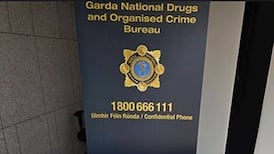Among all the ancient monuments on Tory Island, the most distinctive is the Tau Cross that overlooks the little harbour at Baile Thiar (West Town). One of only four such crosses in Ireland, and by far the largest, it takes its name from a letter of the Greek alphabet.
Shaped like our capital T, the Tau has long symbolised the crucifix for Christians. And according to a sign nearby, the cross on Tory dates from the 12th century, making it much more modern than the ruins of a round tower nearby.
Some have suggested it may be older, even pre-Christian.
In any case, by tradition, local fisherman have always prayed before it when heading out to sea.
Tau was one of the letters said to have been introduced to Greek by the Phoenician hero Cadmus. In the ancient world, it was a symbol of life, whereas another Greek letter, Theta, represented death.
But its Christian-era infamy made it the subject of a legal satire written about 160AD, The Consonants at Law – Sigma versus Tau, in the Court of the Seven Vowels, wherein Sigma demands death by crucifixion for the letter itself:
“Men weep, and bewail their lot, and curse Cadmus with many curses for introducing Tau into the family of letters; they say it was his body tyrants took for a model, his shape that they imitated, when they set up structures on which men are crucified. Stauros the vile engine is called, and it derives its vile name from him. Now, with all these crimes upon him, does he not deserve death, nay, many deaths? For my part I know none bad enough but that supplied by his own shape – that shape which he gave to the gibbet named [...] after him by men.”
In later centuries, the symbol came to be known as “St Anthony’s Cross” after the Egyptian Anthony the Great, patron saint of farmers. This is perhaps because, in old age, he is reputed to have used a crutch of that shape. In western Europe, the Tau is also associated with St Francis of Assisi and the order he founded.
Given its alphabetical properties alone, the cross is an apt landmark for an island called Tory. But Ireland’s other Tao crosses include two miniature ones in Dalkey, Co Dublin, and Kilmakedar, Co Kerry.
Then there is the much-travelled Ineenboy Cross in Clare. That was the subject of national newspaper headlines in 1967, when it was listed as one of several monuments being brought to Dublin for a show to coincide with the first Rosc modern art exhibition.
The then minister for finance, Charles J Haughey had overidden objections from the National Monuments Advisory Council. Architect and writer Niall Montgomery resigned from the council in protest. But in the meantime, the cross went missing, members of a local youth club having carried out a preemptive kidnap and hidden it in a sandpit.
When the exhibition organisers cancelled plans to bring it to Dublin, the cross was re-erected only to disappear again. It then emerged that the exhibitors had decided to go ahead with the show after all. A replica now stands at the site in Kilnaboy. The original cross is in the safer keeping of a local heritage centre.
Tory’s Tau Cross has been less mobile historically, although an old photograph in Robin Fox’s book Tory Islanders – A People on the Celtic Fringe (1978) appears to show only the vertical shaft standing. (In the caption accompanying another of the book’s pictures, curiously, Fox appears to suggest that the cross is so named because “Tau is the Gaelic pronunciation of the letter ‘t’”).
Anthony the Great is not to be confused with Anthony of Padua, by the way, the saint many Irish people still pray to for assistance in finding lost objects. Otherwise, the St Anthony’s cross on Tory might have been invoked in an extraordinary case of the 1990s when a two-storey house that used to stand close to it went missing.
The owner, a Co Down man then mainly resident in New Zealand, arrived on Tory one day in 1994 to find that his holiday home had disappeared. Making inquiries locally, he was met by that metaphorical monument: “a wall of silence”.
Fifteen years later he took civil proceedings against an islander alleged to have demolished the house. And although a judge found there was no proof of what had occurred, the court nevertheless awarded €46,000 damages.
The whole, extraordinary story has been detailed in Anton McCabe’s book, The House that Disappeared on Tory Island (2012), and more recently (2021), by a five-part podcast on BBC Radio 4.
















